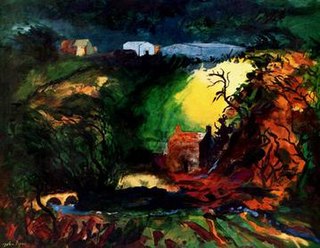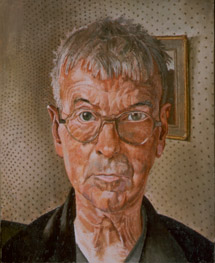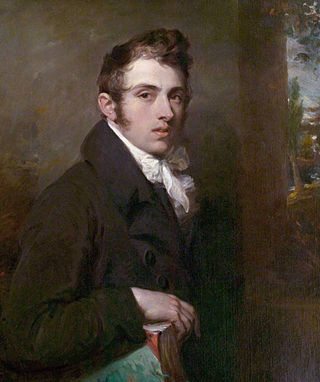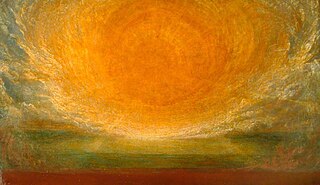
Tate is an institution that houses, in a network of four art galleries, the United Kingdom's national collection of British art, and international modern and contemporary art. It is not a government institution, but its main sponsor is the UK Department for Culture, Media and Sport.

John Constable was an English landscape painter in the Romantic tradition. Born in Suffolk, he is known principally for revolutionising the genre of landscape painting with his pictures of Dedham Vale, the area surrounding his home – now known as "Constable Country" – which he invested with an intensity of affection. "I should paint my own places best", he wrote to his friend John Fisher in 1821, "painting is but another word for feeling".

John Egerton Christmas Piper CH was an English painter, printmaker and designer of stained-glass windows and both opera and theatre sets. His work often focused on the British landscape, especially churches and monuments, and included tapestry designs, book jackets, screen-prints, photography, fabrics and ceramics. He was educated at Epsom College and trained at the Richmond School of Art followed by the Royal College of Art in London. He turned from abstraction early in his career, concentrating on a more naturalistic but distinctive approach, but often worked in several different styles throughout his career.

Sir Stanley Spencer, CBE RA was an English painter. Shortly after leaving the Slade School of Art, Spencer became well known for his paintings depicting Biblical scenes occurring as if in Cookham, the small village beside the River Thames where he was born and spent much of his life. Spencer referred to Cookham as "a village in Heaven" and in his biblical scenes, fellow-villagers are shown as their Gospel counterparts. Spencer was skilled at organising multi-figure compositions such as in his large paintings for the Sandham Memorial Chapel and the Shipbuilding on the Clyde series, the former being a First World War memorial while the latter was a commission for the War Artists' Advisory Committee during the Second World War.

George Frederic Watts was a British painter and sculptor associated with the Symbolist movement. He said "I paint ideas, not things." Watts became famous in his lifetime for his allegorical works, such as Hope and Love and Life. These paintings were intended to form part of an epic symbolic cycle called the "House of Life", in which the emotions and aspirations of life would all be represented in a universal symbolic language.

William Hilton was a British portrait and history painter. He is also known as "William Hilton the Younger".

Mary Seton Fraser Tytler was a symbolist craftswoman, designer and social reformer.

Ceri Giraldus Richards was a Welsh painter, print-maker and maker of reliefs.

John Bellany was a Scottish painter.
Sir Lawrence Burnett Gowing was an English artist, writer, curator and teacher. Initially recognised as a portrait and landscape painter, he quickly rose to prominence as an art educator, writer, and eventually, curator and museum trustee. He was described as a prominent member of the "English Establishment". As a student of art history he was largely self-taught.

Tate Britain, known from 1897 to 1932 as the National Gallery of British Art and from 1932 to 2000 as the Tate Gallery, is an art museum on Millbank in the City of Westminster in London, England. It is part of the Tate network of galleries in England, with Tate Modern, Tate Liverpool and Tate St Ives. It is the oldest gallery in the network, having opened in 1897. It houses a substantial collection of the art of the United Kingdom since Tudor times, and in particular has large holdings of the works of J. M. W. Turner, who bequeathed all his own collection to the nation. It is one of the largest museums in the country. The museum had 525,144 visitors in 2021, an increase of 34 percent from 2020 but still well below pre- COVID-19 pandemic levels. In 2021 it ranked 50th on the list of most-visited art museums in the world.

The Watts Cemetery Chapel or Watts Mortuary Chapel is a chapel in a Modern Style version of Celtic Revival in the village cemetery of Compton in Surrey. While the overall architectural structure is loosely Romanesque Revival, in the absence of any appropriate Celtic models, the lavish decoration in terracotta relief carving and paintings is Celtic Revival, here seen on an unusually large scale. According to the local council, it is "a unique concoction of art nouveau, Celtic, Romanesque and Egyptian influence with Mary's own original style".
Anne-Katrin Purkiss is a photographer, born in Karl-Marx-Stadt, Germany in 1959 and moving to Britain in 1984 after graduating from University of Leipzig in 1983. Her father Joachim Seyffarth (1928-2014) was a German curator of monuments and photographer.

The Memorial to Heroic Self-Sacrifice is a public monument in Postman's Park in the City of London, commemorating ordinary people who died saving the lives of others and who might otherwise have been forgotten. It was first proposed by painter and sculptor George Frederic Watts in 1887, to commemorate the Golden Jubilee of Queen Victoria. The scheme was not accepted at that time, and in 1898 Watts was approached by Henry Gamble, vicar of St Botolph's Aldersgate church. Postman's Park was built on the church's former churchyard, and the church was at that time trying to raise funds to secure its future; Gamble felt that Watts's proposed memorial would raise the profile of the park. The memorial was unveiled in an unfinished state in 1900, consisting of a 50-foot (15 m) wooden loggia designed by Ernest George, sheltering a wall with space for 120 ceramic memorial tiles to be designed and made by William De Morgan. At the time of opening, only four of the memorial tiles were in place. Watts died in 1904, and his widow Mary Watts took over the running of the project.

Hope is a Symbolist oil painting by the English painter George Frederic Watts, who completed the first two versions in 1886. Radically different from previous treatments of the subject, it shows a lone blindfolded female figure sitting on a globe, playing a lyre that has only a single string remaining. The background is almost blank, its only visible feature a single star. Watts intentionally used symbolism not traditionally associated with hope to make the painting's meaning ambiguous. While his use of colour in Hope was greatly admired, at the time of its exhibition many critics disliked the painting. Hope proved popular with the Aesthetic Movement, who considered beauty the primary purpose of art and were unconcerned by the ambiguity of its message. Reproductions in platinotype, and later cheap carbon prints, soon began to be sold.
George Fiddes Watt was a Scottish portrait painter and engraver.

The Last Judgement is a triptych of oil paintings by the British artist John Martin, created in 1851–1853. The work comprises three separate paintings on a theme of the end of the world, inspired by the Book of Revelation. The paintings, The Plains of Heaven, The Last Judgement, and The Great Day of His Wrath, are generally considered to be among Martin's most important works, and have been described by some art critics as his masterpiece.

Mammon, originally exhibited as Mammon. Dedicated to his Worshippers, is an 1885 oil painting by English artist George Frederic Watts, currently in Tate Britain. One of a number of paintings by Watts in this period on the theme of the corrupting influence of wealth, Mammon shows a scene from Edmund Spenser's The Faerie Queene in which Mammon, the embodiment of greed, crushes the weak through his indifference to their plight. This reflected Watts's belief that wealth was taking the place of religion in modern society, and that this worship of riches was leading to social deterioration. The painting was one of a group of works Watts donated to the South Kensington Museum in late 1886, and in 1897 it was one of 17 Watts paintings transferred to the newly created Tate Gallery. Although rarely exhibited outside the Tate Gallery, the popularity of reproductions made Mammon one of Watts's better known paintings.

After the Deluge, also known as The Forty-First Day, is a Symbolist oil painting by English artist George Frederic Watts, first exhibited as The Sun in an incomplete form in 1886 and completed in 1891. It shows a scene from the story of Noah's Flood, in which after 40 days of rain Noah opens the window of his Ark to see that the rain has stopped. Watts felt that modern society was in decline owing to a lack of moral values, and he often painted works on the topic of the Flood and its cleansing of the unworthy from the world. The painting takes the form of a stylised seascape, dominated by a bright sunburst breaking through clouds. Although this was a theme Watts had depicted previously in The Genius of Greek Poetry in 1878, After the Deluge took a radically different approach. With this painting he intended to evoke a monotheistic God in the act of creation, but avoid depicting the Creator directly.
















